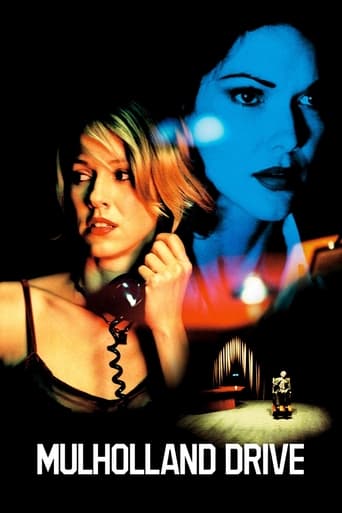

Memorable, crazy movie
... View MoreWhen a movie has you begging for it to end not even half way through it's pure crap. We've all seen this movie and this characters millions of times, nothing new in it. Don't waste your time.
... View MoreAfter playing with our expectations, this turns out to be a very different sort of film.
... View MoreThe film never slows down or bores, plunging from one harrowing sequence to the next.
... View MoreDavid Lynch's Mulholland Drive is a unique movie. Unique because regardless of what you consider- if you liked the film or not- you will think about what you just saw. It is a reactionary film in ways because it toys with your perception. Naomi Watts arrives in Los Angeles as a wide-eyed starlet who finds a mysterious woman, shaken and damaged in her apartment. With her career not going as desired she teams with this woman to solve the mystery of who she really is and how did she come to be in that situation. This is a psychological film with multiple layers and themes which might confuse you. Lynch is an auteur and all his films reek of atmosphere and this one is no different. You should try Mulholland Drive- I enjoyed it and will see it many times in time to come.
... View MoreEver been to a lecture of that overtly fervent English professor who analyzes every single word of a poem when your common sense tells you that it is the most abhorrent load of crap you can ever read? That is what most of these other reviews are analogous to. A movie with a promising beginning, no matter how somber or bleak it might be, sets the foundations at the right corners. I, a mere foolish mortal, anticipated it to be a gripping tale of crime, thriller, and mystery. With the incessant plot and chronology changes, the film looses it's glitz and becomes lackluster. It doesn't make me question my sanity but off those who really call this movie remarkable. With so many undeveloped plot lines, character development, and continuity crises dismissed as a figment of imagination, it feels like Lynch is kicking the audience in the gut with the boot he and his fellow cabal of esoteric film reviewers call art. Don't get me wrong, I love non-linear films. I absolutely adore genuine masterpieces of the arduous genre like Pulp Fiction, Primer, Triangle etc. What separates this abominable movie from the legends, or even the mediocre is that every minute of the film is essential to build up the climax which assuages our grey matter with adrenaline. If you cut out half of the reel, this movie will still make the exact sense, i.e. no sense at all. My request to anyone who is looking forward to witness this mind-numbing atrocity is to not be deluded by pseudo-intellectual reviews proclaiming how 'brilliant' this kick in the nuts is. They have no real educational qualifications or aptitude and want to feel what being an erudite feels like by joining a small little circle of nincompoop intelligentsia lauding Mulholland Drive as an artistic venture when it really is an eye gouging experience what the viewer has to endure and validate because of social pressure enshrouding it.
... View MoreMulholland Drive is a unique mystery movie directed by David Lynch. The movie is incredibly hypnotic with much of the visual contributing to a dream-like state. This is a positive in the movie's favor as it adds to the themes and setting of the movie. I highly recommend this movie to any audience looking for something different.
... View MoreTo explain my take would take a very long time, so I will just mention a couple of aspects ... the film is shot through with references to Greek mythology ... note that the old people in the early sequences are exaggeratedly kind and smiley ... and in the later scenes how they harass and drive Diane to madness? ... the old lady says her name is Irene ... in Greek myths, the Eryines are entities which can either be "The Kindly Ones", which is what the name means, but they are also The Furies, who hound and harass the guilty, especially those guilty of murder, to madness and death. In both roles they preside over justice. Another Greek myth is represented by the mysterious blue box, which, when it is opened by Betty/Diane, brings her back to the sordid, crime ridden world of the second half, after the suspiciously glamorous and successful first half populated by "Betty" and "Rita" ... this, I believe is Pandora's box, which released all the evils of the world ... it is also probably a reference to Alice's rabbit-hole, which also takes her to what I believe is a nightmarish, rather than a dream world. The scenes in the diner belong to the evil world of the second half, but they leak into the dream world as flashes of reality into "Betty's" consciousness., There is also a scene in the cafe, where, hardly noticed in the background, a body is dumped in a dumpster ... was this the body of Camilla, killed by the hitman Diane hired? This, I believe is the guilt Diane experiences as her lover's murderer So, the first part represents the fantasy life that Diane, as "Betty" has constructed for herself ... see how easily she waltzes into a very successful audition? ... after the box, she is plunged into a much harder, philistine, money and gangster dominated, cynical world of Hollywood, symbolised by the hideous man at the back of the diner, and by the cowboy.
... View More